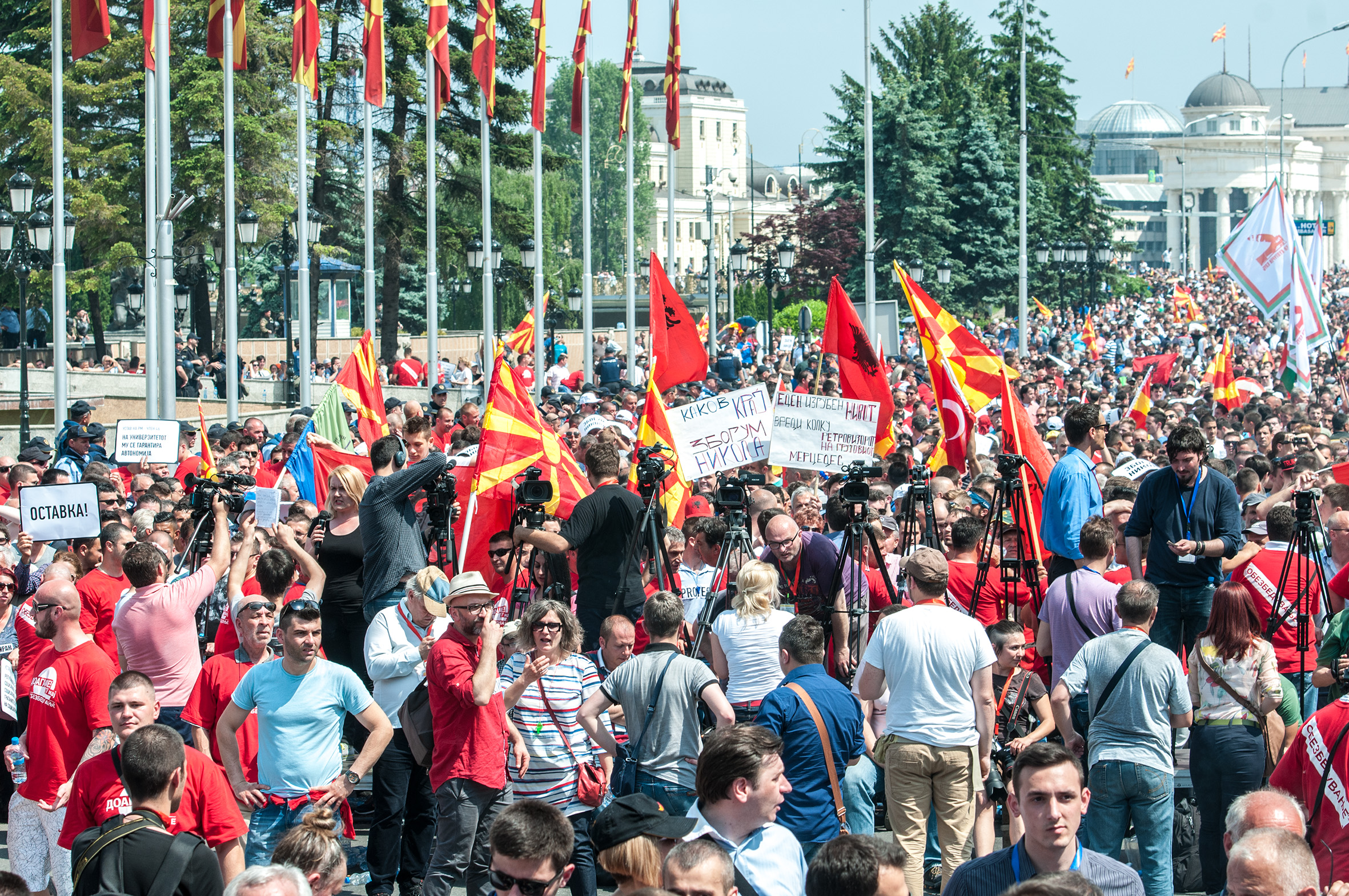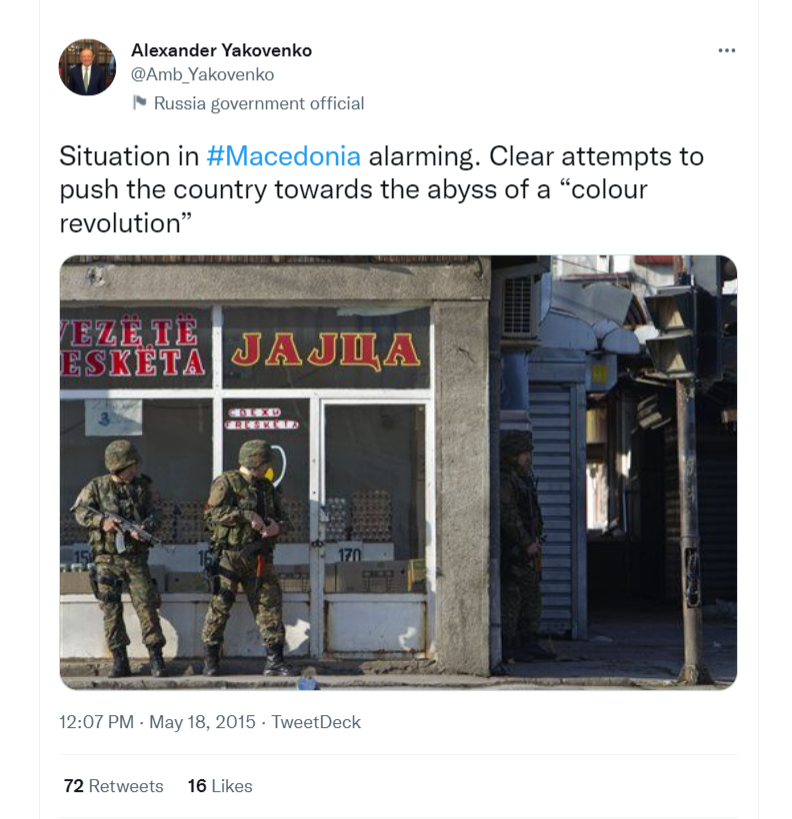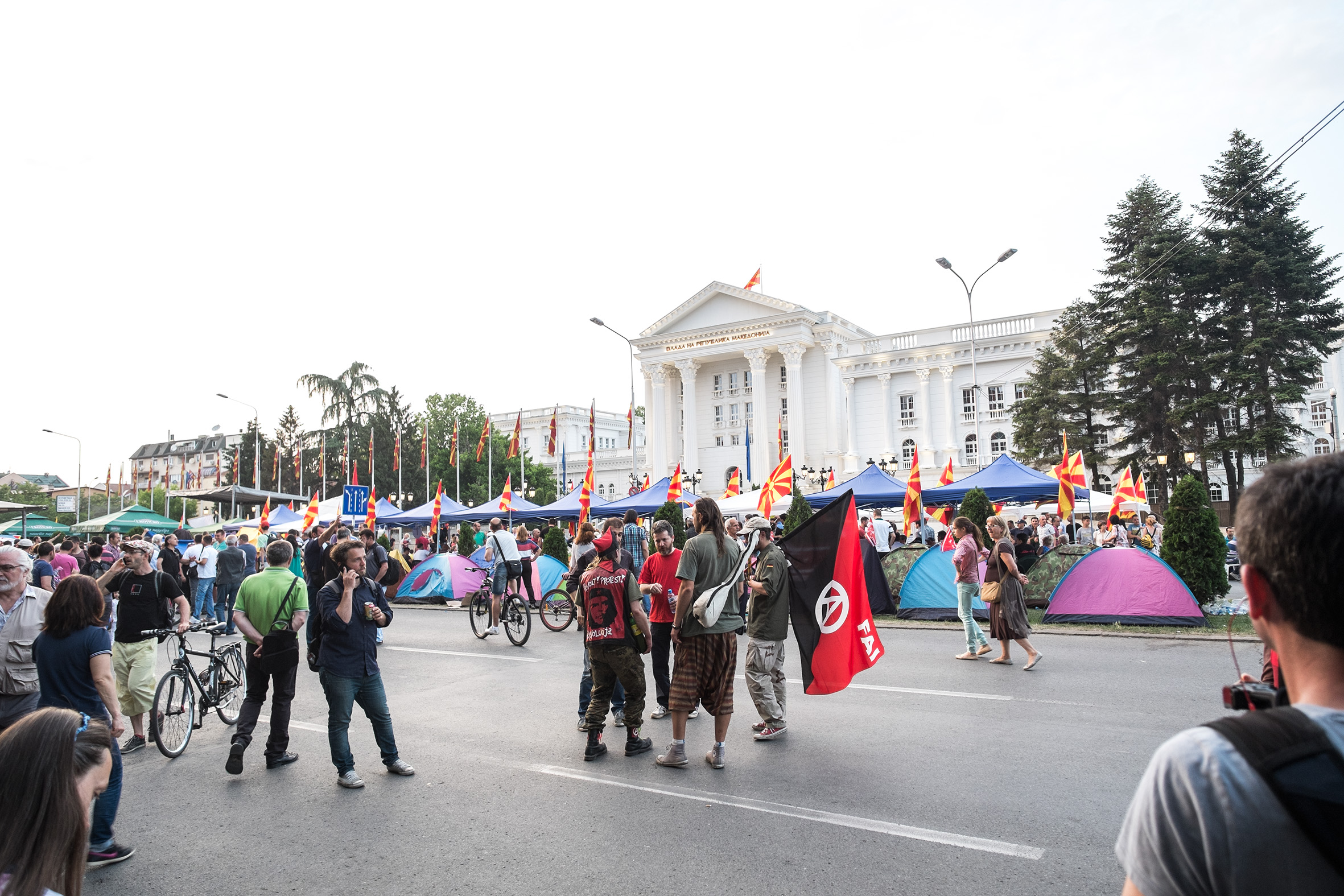Analysis of the disinformation and conspiracy theories about the “Ukrainian scenario”, the “colored revolution” and the “Macedonian Maidan” with which Russian propaganda and its local allies in 2015 imposed narratives to justify Russian aggression against Ukraine and anti-democratic populist regimes of Putin and Gruevski, writes Truthmeter.mk.
Under the syndicating agreement between Truthmeter.mk and Meta.mk, we republish the text below:
Author: Žarko Trajanoski, media analyst
The propaganda efforts of official Russia, which sought to discredit the anti-government protests in Kazakhstan as a “colored revolution” directed and planned in the West, fall within the realm of “already seen” communication strategies. On the same day that Kazakh President Kasim-Zhomart Tokayev propagated a coup attempt and aggression by “foreign militants”, Russian President Vladimir Putin spoke of measures to prevent a scenario of “colored revolutions” and the application of “Maidan technologies” in Kazakhstan.
The term “colored revolutions” is an integral part of the Kremlin’s official communications, especially after the events in Ukraine known as the “Orange Revolution” of 2004 and the Euromaidan of 2012.
Moscow sees the “colored revolutions” as a security threat not only to Russia but also to the world, especially after the end of the “Ukrainian (Maidan) Revolution” in February 2014. Putin also spoke of the threats of “colored revolutions” at the “Third Moscow International Conference on International Security”, which takes place shortly before the election of Petro Poroshenko as President of Ukraine on May 25, 2014. The conference described the “colored revolutions” as factors for destabilization around the world, and the criteria for “exporting” “colored revolutions” and the aspects of “information warfare” are highlighted.
The “colored revolutions” are not only part of Russia’s military-political propaganda, but also part of the military-political doctrine to suppress them. An indicator of this is the joint “Slavic Brotherhood” exercises in 2015, which included Russian, Belarusian and Serbian troops, aimed at combating a “potential Maidan scenario”, including in the Balkans. There are serious indications of other activities by Serbia and Russia to oppose “colored revolutions”.
The Russian military-political propaganda and doctrine of the “colored revolutions” was applied in the context of the political crisis in the Republic of Macedonia in 2015. Macedonia was the target not only of propaganda communications from official Russia but also fertile ground for disinformation and conspiracy theories about the “Ukrainian scenario”, the “colored revolution” and the “Macedonian Maidan”.
In this analysis we will focus only on the first period of the political crisis – from the announcement of the “Coup” case to the final “Pržino Agreement” – a political framework for the peaceful overcoming of the Macedonian political crisis in 2015, which temporarily dispels the dark conspiracy theories for a bloody “colored revolution.” In the second period of the political crisis – from the formation of the SPO, to the holding of early elections in December 2016, as well as in the third period – after the early elections to the formation of the political government on May 31, 2017, there were Russian conspiracy theories and disinformation for a “colored revolution” in Macedonia, which will be the subject of additional analysis.
The beginning was a “coup” – “Ukrainian scenario” and a prevented “colored revolution”
Although there were announcements of a “Ukrainian scenario” before the 2014 elections, and at the end of 2014, the term “Ukrainian scenario” was especially exploited after the “official” start of the political crisis in Macedonia in 2015.
The beginning of the political crisis is usually considered the date when the then Prime Minister Nikola Gruevski publicly accused the then opposition leader of SDSM, Zoran Zaev, of attempting a coup in cooperation with “foreign services” (the so-called “Coup” case ). This was followed by criminal charges from the Ministry of Interior, which “informed” that “for the first time in history, a case was realized in which an attempt was made to endanger the constitutional order and undemocratic takeover of power.” Official Moscow immediately reacted with a “strategic communication” in which the official story of a prevented “coup d’etat” by the SDSM leadership, in cooperation with “foreign services”, was supported. This surprising communication from Moscow provoked media headlines with a “Ukrainian scenario” and analysis that the statement of the Russian Foreign Ministry in the “Coup” case is aimed at supporting Russian interests in Ukraine.
At the same time, pro-government propagandists launched a fierce campaign against Zoran Zaev who received footage from foreign services. Serbian and pro-Russian military-political propagandist Miroslav Lazanski, who later became Serbia’s ambassador to Russia, also took part in the defamation campaign against Zaev. His statements were popularized in a political show with the pro-Russian host Milenko Nedelkovski on Kanal 5, one of the most-watched TV stations.
Prior to the release of the footage by the opposition (popularly called “bombs”), conspiracy theories spread in the Macedonian media in an attempt to create a “Ukrainian scenario”, followed by accusations that Zaev “with some ‘foreign service’ allowed the wiretapping of the entire state leadership and a large number of citizens”.
After Zaev on February 9, 2015, accused the then Prime Minister Gruevski and his first cousin (head of the secret police), Sašo Mijalkov, of mass wiretapping of thousands of citizens, conspiracy theories about a “Ukrainian scenario” and “colored revolution” began to spread in the Macedonian media, reinforced by pro-Russian propagandists.
For example, pro-Russian conspiracy theorist Umberto Pascali, in an interview with “Sonce TV” in the program “Voice of the People”, explicitly accused him of a desperate attempt to provoke a “sorosoid” “color revolution” to destabilize Macedonia. Pascali’s messages were disseminated with dozens of articles with headlines such as “Pascali: Macedonia avoided the Ukrainian-style tragedy, Zaev’s plot ended in a farce” on popular TV channels such as Sitel and Kanal 5, as well as dozens of other media.
Other pro-Russian analysts on Russian propaganda channels have personally accused US officials of “a Kiev-style coup in Macedonia”, claiming that “Zaev’s bombs” were given to him by the CIA. Such conspiracies broke out in the Macedonian pro-government media at the time, with accusations that “After Bulgaria and Ukraine, the oilmen are destroying Macedonia ?!”, with Soros being accused not only of financing the failed “Macedonian Maidan”, but also of wiretapping as much as 20,000 Macedonians.
“Color Revolution” in Skopje same as the one in Kiev, “Turkish Stream” and “Greater Albania”
While the opposition published footage showing corruption and lawlessness by the government, Russia’s propaganda theory of a “colored revolution” was making its way into the Macedonian media. For example, Sputnik’s propagandist Andrei Korybko, portrayed as a “Russian analyst” on Sonce TV, would point out that “Macedonia is in the midst of a deliberate ‘colored revolution’, with Zaev unsuccessfully trying to take Macedonians to the streets to turn Skopje into Kiev “.
Koribko’s propaganda theses were disseminated in the Macedonian pro-government media and on Russian propaganda channels. In his radio show, Korybko will also interview guests who will support the propaganda thesis that the attempted “coup d’etat” in Macedonia is, in fact, a “colored revolution”, and that it is related to the conspiracy theory to prevent the “Turkish stream”. One of the guests, the host of a Macedonian propaganda show in which his Russian host previously appeared as an analyst, will point out that “Macedonia is not Ukraine”, that it will not be destabilized, that there will be no “colored revolution” or civil war, and that support for the “Balkan Stream” is great. The story of the connection between the “Turkish Stream” and the “colored revolution” caused by the West was the subject of other Russian propaganda channels that offered geopolitical arguments, aimed not only at Macedonia but also at Serbia and Bulgaria.
After Putin reiterated the threat to international security at an international conference in Moscow in April 2015 from various scenarios of “colored revolutions” that cause violence and chaos, Russian propaganda channels continued to conspire for a colored revolution in Macedonia.
They also introduced new elements – “Albanian terrorism” and “Greater Albania”. An anxious Moscow reacted after the armed attack near Gošince, when the Macedonian border police watchtower was attacked by an armed group from Kosovo. At the same time, Sputnik accused the United States of trying to transform the failed “colored revolution” in Macedonia into an unconventional war that would neutralize the geostrategic route to the “Turkish Stream”. The message that “Gošince is part of the ‘colored revolution’ in Macedonia” was spread in the Macedonian media by other pro-Russian propagandists.

Protest in Skopje on 17.05.2015 Photo: Vanco Dzambaski, CC BY-NC-SA.
Officialization of the propaganda story of the “colored revolution” against the “Turkish stream”
Russia’s “unofficial” propaganda story – that an attempt at a “colored revolution” is taking place in Macedonia, which is directly related to Russia’s “Turkish Stream” energy project, became “official” only after Russian Foreign Minister Sergei Lavrov’s visit to Belgrade on May 15, 2015.
Previously, three key events took place in Macedonia that ignited the political crisis: Police brutality of the protests on May 5, 2015, which were precisely against police brutality, the announcement of a mass opposition protest on May 17 which was propagandistically attacked as a “Ukrainian scenario”, and the armed conflict in Kumanovo on May 9-10, 2015, after which the then President Gjorge Ivanov had to interrupt his visit to Moscow to mark the victory of fascism and convene the Security Council.
A few days after the dramatic conflict, on May 12, the Minister of Interior and the head of the secret police – Nikola Gruevski’s first cousin – resigned, and another minister for whom major abuses were revealed in the published recordings. The conflict has been interpreted by Russian propagandists as a “devilish plan to destabilize Macedonia”, with opposition leaders dubbed “Arseniy Yatsenuk and Petro Poroshenko from Macedonia”.
Ivanov decided to attend a grand parade in Moscow on May 9 in the face of a Western boycott of Russia’s annexation of Crimea, and his presence, originally announced by Russian Foreign Minister Sergei Lavrov, was defended by the phrase “a policy of openness to all”. At the meeting with Putin, according to Ivanov’s cabinet, “mutual satisfaction with the continuous positive trend in relations” was expressed.
In May 2015, the (pro) Russian propaganda machinery was particularly preoccupied with Macedonia. The interpretation of the political situation in Macedonia through the prism of “colored revolution” and “Ukrainian scenarios” continued. At the same time, demonizing parallels with Ukraine and dark geostrategic conspiracy theories were spread by calling on “Greater Albania”. Therefore, it is not at all surprising that Russian Minister Lavrov during his visit to Belgrade on May 15, 2015, received an explicit question whether there is a parallel between the situation in Ukraine and Macedonia. Lavrov sent a message that the events in Macedonia and pro-Russian policies were related, that is, that they had to do with Macedonia’s refusal to impose sanctions on Russia and plans to build the “Turkish Stream” gas pipeline. A day after Lavrov “verified” the “Turkish Stream” conspiracy theory, previously communicated on Russian propaganda channels, the Russian Foreign Ministry answered in the affirmative to a direct question avoided by Lavrov, pointing out that the country was plunged into the abyss of a “colored revolution”.
The stories of “The Color Revolution” and “The Counter-Color Revolution” in May 2015
Given the big propaganda story from Moscow about an attempt at a “colored revolution” in Macedonia, the Macedonian pro-government media from the time tried to discredit the big protest announced by the opposition on May 17, 2015, as a “Ukrainian scenario”. A column entitled “Ukrainian Scenario” even anticipates a request for military assistance from the “Donbass commanders Motorola or Prizren” who would be deployed in Polog.
Some pro-government media outlets issued dramatic warnings that there was a “bloody and infernal plan for violence” on May 17, and propaganda predictions of a “Ukrainian scenario”, that is, of violent protests “at the behest of Ukraine”.
Contrary to the gloomy media predictions, on May 17, 2015, a mass peaceful opposition protest took place, with legitimate democratic demands by the opposition. After the propaganda announcements for a hellish “Ukrainian scenario” did not come true, the Russian propaganda channels spread the theory that the violence on May 17 was prevented.
During this period, it can be seen that Russian propaganda uses flagrant disinformation in an attempt to discredit opposition leader Zoran Zaev, imputing to him statements containing threats of war. Russian propaganda tried to spread disinformation that the then leader of SDSM, Zaev, speaking at a mass protest on May 17, 2015, said that if Gruevski did not leave, “Macedonia will withness war, as in Ukraine.” Zaev did not make such a statement at the protest rally of the “Citizens of Macedonia”, nor did the Macedonian media report that there were any threats of war in Zaev’s speech, “as in Ukraine”.

A day after a mass opposition protest in front of the government, there was also a mass pro-government protest in front of the assembly where the opposition was accused of “organizing Ukrainian drama” and the opposition leader was compared to a “Ukrainian Klitschko”. Initially, “Sputnik” published information that there were 30 thousand people at the pro-government protest, for the next day the pro-government protest to be declared “the largest in the history of the country”, which was attended by 90 thousand people.
On May 19, 2015, the Russian propaganda machinery sent a message that “the coup attempt by the West will not succeed in Macedonia.” The Russian “Pravda” accused the West of “acting in Macedonia following the Kiev Maidan scenario”, and advocated the idea that Russia must build a strong Orthodox coalition in Europe to defeat the West.
At the end of May 2015, when he received the new Macedonian ambassador to Russia, Putin supported the Macedonian authorities in normalizing the situation, noting that Russia and Macedonia have “deep historical roots, cultural and spiritual closeness.”
Even after the large opposition and pro-government protests, Russian propaganda did not rest. Russian Foreign Minister Lavrov made explicit parallels between the situation in Macedonia and Ukraine, reiterating the thesis that events in Macedonia are orchestrated from the outside, as a result of the refusal to impose sanctions on Russia and the support of “Turkish Stream”. Lavrov accused of the external use of the “Albanian factor”, and spread conspiracies for further federalization of Macedonia and division of the country between Albania and Bulgaria.
The formation of an opposition camp in front of the government building has intensified the dark theories of a “Ukrainian scenario” and a civil war. The opposition was propagandistically discredited and branded by the Russian media as the “fifth column”, which wants to create a “new Maidan, as in Ukraine”, i.e. a new “colored revolution”. Some Russian propagandists have even tried to call it a failed “lipstick revolution.”

Despite denigrating and underestimating the number of the “colored revolution”, Sputnik favored the “counter-colored revolution” – as resistance against foreign interference and popular support for a democratically elected leadership that opposed sanctions on Russia and sent its leader to a celebration on May 9, 2015, in Moscow. On the Russian propaganda channels, Macedonia was treated as a new example of successfully opposing the “colored revolutions”, with the so-called “Mass anti-Maidan demonstrations.” The “Macedonian Resistance” received open congratulations from the Russian propagandists for successfully dealing with the attempt for a “colored revolution”.
Of course, Russian propaganda actively aided the so-called “counter-colored revolution”, with attempts to discredit the opposition camp in front of the government, which organized civic debates and sought solutions for a peaceful way out of the crisis. For example, the famous Russian TV host and propagandist Dmitry Kiselev on May 24, 2015, will announce the propaganda article for the opposition camp as “Maidan in Macedonia” which continues to develop according to the classic “Ukrainian scenario”. Although the propaganda article contains a statement by the opposition leader Zaev who sends explicit messages against the use of violence, the whole article is an attempt to draw a discrediting parallel between the violent “Maidan” in Ukraine and Macedonia. Opposition campers in front of the government are denigrated as neo-Nazi activists or hooligans trained and paid by Soros to provoke violent protests.
Even after Zaev explicitly distanced himself from “Ukrainian scenarios”, Russian officials continued to conspire theories of a “colored revolution”. For example, Russian Deputy Defense Minister Antonov will point out at an international conference that a wave of “colored” revolutions launched from outside has reached Macedonia, comparing the “epidemic of ‘colored revolutions’ in the Middle East” to a devastating hurricane.
“Color Revolution” and “Ukrainian Scenario” in the Context of the “Pržino Agreement”
The Macedonian political crisis in 2015 was temporarily overcome with the “Pržino Agreement” (June 2 and July 15, 2015) – a political framework based on European democratic principles, which provided for early parliamentary elections in 2016, the return of the opposition to parliament, the two government ministers from the opposition and a new special public prosecutor.
However, even when it was clear that a political agreement would be reached, the Russian propaganda matrix continued with conspiracy theories about a violent “Ukrainian scenario” launched from outside. Sputnik Serbia explicitly accused the Americans and the British of organizing the attacks in Kumanovo.
At the same time, the idea of a “Greater Albania” became relevant on pro-Russian propaganda channels. For pro-Russian propagandists, the political crisis in Macedonia exploited through the prism of the “Ukrainian scenario” was a great occasion for targeting US policies, and those of their officials in the Balkans.
Even when pro-Russian media prophecies about a hellish “Ukrainian scenario” in Macedonia did not materialize in the summer of 2015, Russian propagandists continued to target opposition leader Zaev as “Poroshenko or Yatsenuk.” Even after the signing of the “Pržino Agreement”, the Russian propaganda channels proposed pro-Russian solutions to the political crisis – the unification of the opponents of the EU policies in Macedonia with an ally like Russia and other BRICS countries.
Conclusion: Moscow’s colored propaganda for a “colored revolution”
The political crisis in Macedonia in 2015 was used as fertile ground for Russian “strategic communications”. The sensationalist expressions “Ukrainian scenario”, “colored revolution” and “Macedonian Maidan” were part of a well-organized propaganda campaign in 2015.
The propaganda campaign was biased and “colored”, with the obvious aim of denigrating and delegitimizing the pro-Western opposition and legitimizing a government accused of corruption, election fraud, and abuse of institutions for party and private purposes.
Sowing fears of a “Ukrainian scenario”, a “colored revolution” and a “Macedonian Maidan”, Russian propaganda has successfully exploited the Macedonian political crisis from the very beginning – not only to target the West, NATO and the EU as destabilizing factors but also to increase its political influence in Macedonia and the Balkans. The Russian propaganda campaign in Macedonia continued with the deepening of the political crisis in 2016 and 2017, as we will see in the second part of the analysis.



















![Young people in a three-day-workshop learned about data visualization [Gallery]](https://meta.mk/wp-content/uploads/2023/12/obuka-za-vizuelizacija-na-podatoci-vo-dekemvri-2023--100x70.jpg)




